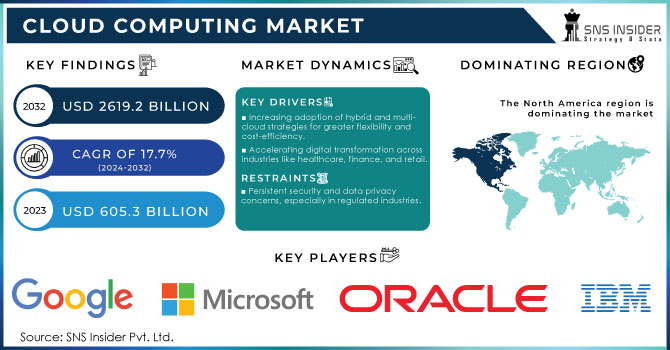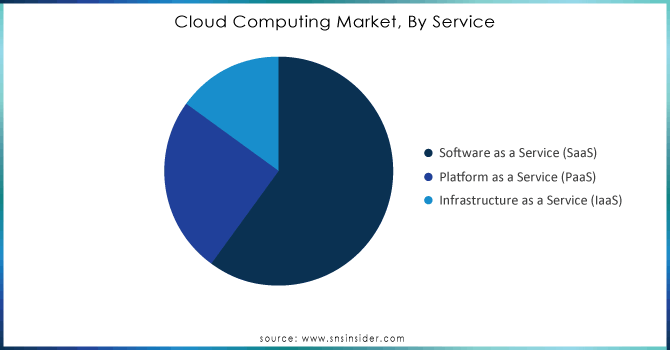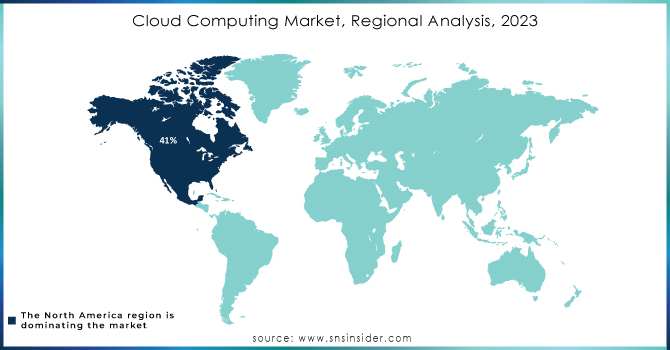Cloud Computing Market Report Scope & Overview:
Cloud Computing Market was valued at USD 605.3 billion in 2023 and is expected to reach USD 2619.2 billion by 2032, growing at a CAGR of 17.7% from 2024-2032.
This report includes a detailed regulatory analysis, examining key policies influencing market growth. It highlights network infrastructure expansion by region in 2023, alongside the rise in cybersecurity incidents from 2020-2023, including estimated weekly attacks. Adoption rates of emerging technologies are also analyzed, offering insights into shifting trends. Additionally, the report explores cloud services usage by region, providing a comparative outlook. An emphasis is placed on green cloud technologies and their carbon impact, addressing sustainability concerns. This comprehensive overview ensures a clear understanding of current and future market dynamics, helping stakeholders navigate the evolving cloud landscape.
U.S. Cloud Computing Market was valued at USD 178.66 billion in 2023 and is expected to reach USD 677.09 billion by 2032, growing at a CAGR of 15.95% from 2024-2032.
Growth is driven by rapid digital transformation across industries, increasing adoption of AI, big data analytics, and IoT, and a strong push toward remote and hybrid work models. Enterprises are shifting from traditional IT infrastructure to scalable, cost-efficient cloud services. Government initiatives supporting cloud adoption and stringent data security regulations further bolster market demand. Moreover, the expansion of hyperscale data centers and increased investments in edge computing and 5G technologies continue to accelerate cloud deployment across sectors, solidifying the U.S. as a global leader in cloud innovation.

Get more information on Cloud Computing Market - Request Sample Report
Market Dynamics
Drivers
-
Growing demand for scalable IT infrastructure to support remote work, data storage, and business continuity is fueling market expansion
Growing demand for expandable IT infrastructure is strongly leading to the growth of cloud computing across sectors. Companies are making a growing trend from on-site systems to cloud-based systems in order to promote operational efficiency, support remote workforce, and achieve easy access to data from any location. Business continuity, particularly in uncertain settings, is fostered by cloud services' elasticity, and sudden scaling according to demand fluctuations. Enterprises gain benefits of lower IT costs, seamless updates, and little infrastructure spending. Furthermore, the increasing prevalence of cloud-native applications and microservices is building pressure on needing scalable platforms. With companies endeavoring to enhance their agility and resilience, the cloud provides unequalled scalability, accessibility, and dependability. Such benefits are persuading businesses to invest higher in cloud infrastructure, accelerating the market's growth pattern relentlessly across industries.
Restraints
-
Security concerns surrounding data breaches, unauthorized access, and compliance risks are limiting broader enterprise adoption of cloud solutions
Security concerns are a critical limitation affecting the extensive use of cloud computing services. Enterprises are subject to ongoing concern about data breaches, unauthorized access, and exposure of sensitive data. In spite of the strong security mechanisms provided by large cloud vendors, companies are still worried about shared responsibility models and off-premises risks of storing sensitive data. Moreover, regulations like GDPR, HIPAA, and sector-specific norms contribute to the added complexity of cloud migration. Any misconfiguration or lack of monitoring can result in legal and financial issues. Fears regarding internal threats, cyberattacks, and sovereignty of the data make these concerns even more intense. This constraint is especially significant for industries such as finance and healthcare, where data security is a top priority. Therefore, these risks are preventing some businesses from going all out on cloud adoption.
Opportunities
-
Expansion of edge computing and IoT ecosystems is creating demand for hybrid and multi-cloud architectures across industries
Growth of edge computing and Internet of Things (IoT) ecosystems is fueling the need for hybrid and multi-cloud solutions. As more devices become connected across industries such as manufacturing, healthcare, and transportation, the need for processing lower latency nearer to sources of data increases. Edge computing supports real-time response and analysis, but connection to centralized cloud environments is necessary for general scalability and management of data. Such an ecosystem is driving the growth of hybrid cloud deployments that leverage public and private environments to best support performance. Enterprises are also adopting multi-cloud strategies in order to avoid vendor lock-in and increase flexibility. The confluence of IoT, edge, and cloud platforms offers tremendous opportunity for providers to provide tailored end-to-end solutions. This blending is transforming the cloud computing scenario and opening new growth opportunities
Challenges
-
Complexity in managing multi-cloud environments and vendor lock-in is creating operational and integration challenges for enterprises
Complexity in managing multi-cloud infrastructure is a fast-evolving concern for organizations embarking on varied cloud strategies. Organizations tend to engage with several cloud providers to prevent reliance on one, improve performance, and conform to regulatory needs. This results in fragmented infrastructure, disparate security policies, and integration challenges across platforms. Every cloud service possesses different APIs, billing methods, and management consoles, so its unified governance and optimization become difficult. Moreover, vendor lock-in issues remain, since the migration from one platform to another may entail prohibitive expense and business disruption. Interoperability issues among cloud ecosystems introduce another layer of complication. Sophisticated tools and trained professionals are needed to navigate such environments optimally. Such issues create immense hurdles to painless cloud usage, stifling the promise and slowing down cloud transformation at an enterprise level.
Segment Analysis
By Service
Software as a Service led the Cloud Computing Market in 2023 with the largest revenue percentage of approximately 49% because it is cost-effective, scalable, and easy to deploy. Companies from various industries opt for SaaS solutions for CRM, ERP, and collaboration applications, minimizing complicated infrastructure management. The pay-as-you-go pricing and regular updates appeal to businesses demanding flexibility and low maintenance. SaaS also facilitates remote work and worldwide accessibility, which further boosted its usage during and post-pandemic.
Infrastructure as a Service is expected to grow at the fastest CAGR of approximately 19.63% during the forecast period of 2024 to 2032, with the increasing need for scalable computing resources and data storage services. Small and medium enterprises and enterprises are shifting away from on-premises infrastructure to IaaS to maintain cost control, agility, and rapid deployment. The spread of AI, big data, and IoT applications also drives IaaS adoption, as they necessitate high-performance computing and large-scale storage infrastructures.

Need any customization research/data on Cloud Computing Market - Enquiry Now
By Enterprise Size
Large Enterprises led the Cloud Computing Market with the largest revenue share of around 63% in 2023 because they have large IT budgets, intricate infrastructure requirements, and international operations. These companies increasingly depend on cloud solutions to improve scalability, security, and operational efficiency. They spend on cloud-based analytics, disaster recovery, and enterprise applications to aid digital transformation and competitiveness. Moreover, their requirement for handling large volumes of data and maintaining business continuity further propels cloud adoption across various business functions.
Small & Medium Enterprises (SMEs) are anticipated to expand at the fastest CAGR of approximately 18.88% during 2024-2032, as they look for cost-effective and scalable cloud solutions to compete with big companies. Cloud computing offers SMEs access to enterprise-grade tools without large upfront costs, enabling agility, remote work, and digital customer engagement. Government support and increasing awareness of cloud benefits among SMEs also contribute to adoption, especially in developing economies where digitalization is accelerating rapidly.
By Deployment
Public cloud segment led the Cloud Computing Market with the highest share of revenues, approximately 43%, during 2023, due to affordability, convenience in access, and extensive scalability. Public clouds are extensively utilized by organizations to host applications, store data, and execute workloads without worrying about infrastructure administration. Key players such as AWS, Microsoft Azure, and Google Cloud provide strong security, flexibility, and worldwide presence, making public cloud a favorite among companies looking to minimize capital costs and shorten deployment timelines.
The Hybrid cloud segment is expected to expand at the fastest CAGR of around 21.00% during the forecast period from 2024 to 2032, owing to the growing demand for flexibility, data sovereignty, and workload optimization. Organizations are merging on-premise infrastructure with private and public clouds to build tailored environments that reconcile control and scalability. Hybrid configurations enable smooth data mobility, disaster recovery, and regulatory compliance, particularly for industries such as finance and healthcare. The need for hybrid solutions increases with the increase in edge computing and IoT.
By Workload
Application Development & Testing led the Cloud Computing Market in 2023 with the largest revenue share of nearly 28%, driven by the increasing need for agile development, continuous integration, and accelerated time-to-market. Cloud platforms offer developers scalable environments, automated tools, and testing frameworks that lower the cost and enhance the quality of software. Companies and startups utilize cloud services for DevOps, mobile application development, and software lifecycle management, so the segment is a central part of digital transformation programs among industries.
Resource Management is expected to grow at the fastest CAGR of approximately 19.77% from 2024 to 2032, as companies seek to streamline cloud expenditure, capacity planning, and workload distribution. Sophisticated monitoring, automation, and analytics tools enable businesses to manage computing resources in an optimal manner and eliminate wastage. With hybrid and multi-cloud environments becoming increasingly complex, monitoring of resources in real-time and cost governance become imperative. This creates demand for smart resource management solutions in industries such as IT, manufacturing, and retail.
By End-use
The BFSI segment led the Cloud Computing Market with the largest revenue share of around 20% in 2023 as a result of its keen emphasis on security, compliance, and delivery of digital services. Banks and financial institutions are deploying cloud-based core banking systems, fraud detection, and customer analytics to improve operational efficiency and customer experience. The use of cloud enables 24/7 operations, disaster recovery, and fintech application innovation, which makes it part of the continuous digital transformation of the financial industry.
The Manufacturing segment is expected to grow at the fastest CAGR of approximately 21.16% during the period 2024-2032, fueled by the fast growth of Industry 4.0 technologies. Cloud computing is being used by manufacturers for real-time monitoring, predictive maintenance, supply chain optimization, and smart factory operations. Cloud platforms allow for easy integration of IoT, robotics, and AI across production lines. As manufacturers seek efficiency, scalability, and cost savings, cloud-based solutions are becoming key to attaining competitive edge in global markets.
Regional Analysis
North America dominated the Cloud Computing Market in 2023 with the highest revenue share of about 39%, owing to the strong presence of major cloud service providers such as Amazon Web Services, Microsoft Azure, and Google Cloud. The region benefits from advanced IT infrastructure, high cloud adoption across industries, and significant investments in AI, big data, and cybersecurity. Enterprises in North America are early adopters of digital transformation, leveraging cloud technologies for scalability, innovation, and competitive advantage across sectors like finance, healthcare, and retail.
Asia Pacific is expected to grow at the fastest CAGR of about 20.09% from 2024 to 2032, driven by rapid digitalization, expanding internet penetration, and increasing cloud adoption among small and medium enterprises. Countries like China, India, and Southeast Asian nations are witnessing growing investments in cloud infrastructure and smart city projects. The rising demand for remote work, e-commerce, and mobile applications further accelerates cloud deployment. Government initiatives supporting digital transformation and local data centers also boost market expansion across the region.

Recent News
-
In April 2024, Google introduced Axion, a custom Arm-based server chip designed to make cloud computing more affordable. Expected to launch later in the year, Axion will power YouTube ad workloads, positioning Google alongside competitors like Amazon and Microsoft. Snap has shown early interest in the technology.
-
In January 2024, American Tower partnered with IBM to enhance cloud solutions by integrating IBM’s hybrid cloud technology and Red Hat OpenShift into its Access Edge Data Centers. This will enable businesses to leverage IoT, 5G, AI, and network automation for digital transformation.
-
In January 2024, Eviden and Microsoft announced the expansion of their partnership in order to enable Microsoft Cloud and AI solutions across various segments. Overall, Eviden’s move will support its global network growth strategy.
-
In March 2023, the U.S. Department of Defense announced the awarding of its Joint Warfighting Cloud Capability contract, value at $9 billion, to major cloud providers, including AWS, Microsoft, Google, Oracle and others. The contract is part of the Pentagon’s policy to switch to the multi-cloud system, aimed at national security and defense.
-
The European Union launched the Gaia-X initiative in June 2023, a European cloud ecosystem was created to satisfy the requirements of data sovereignty and security. The initiative is supported by the EU law, the €5 billion worth Gaia-X foundation, according to the EU government official publications. This act is expected to reduce the U.S.-based cloud providers in Europe.
Key Players
-
Amazon Web Services (AWS) (EC2, S3)
-
Microsoft (Azure Virtual Machines, Azure Storage)
-
Google Cloud (Google Compute Engine, Google Kubernetes Engine)
-
IBM (IBM Cloud Private, IBM Cloud Kubernetes Service)
-
Oracle (Oracle Cloud Infrastructure, Oracle Autonomous Database)
-
Alibaba Cloud (Elastic Compute Service, Object Storage Service)
-
Salesforce (Salesforce Sales Cloud, Salesforce Service Cloud)
-
SAP (SAP HANA Enterprise Cloud, SAP Business Technology Platform)
-
VMware (VMware vCloud, VMware Cloud on AWS)
-
Rackspace (Rackspace Cloud Servers, Rackspace Cloud Files)
-
Dell Technologies (VMware Cloud Foundation, Virtustream Enterprise Cloud)
-
Hewlett Packard Enterprise (HPE) (HPE GreenLake, HPE Helion)
-
Tencent Cloud (Tencent Cloud Compute, Tencent Cloud Object Storage)
-
Adobe (Adobe Creative Cloud, Adobe Document Cloud)
-
Red Hat (OpenShift, Red Hat Cloud Infrastructure)
-
Cisco Systems (Cisco Webex Cloud, Cisco Intersight)
-
Fujitsu (Fujitsu Cloud Service K5, Fujitsu Cloud IaaS Trusted Public S5)
-
Huawei (Huawei Cloud ECS, Huawei Cloud OBS)
-
Workday (Workday Human Capital Management, Workday Financial Management)
-
NetApp (NetApp Cloud Volumes, NetApp Cloud Insights), and others players.
| Report Attributes | Details |
| Market Size in 2023 | US$ 605.3 Billion |
| Market Size by 2031 | US$ 2619.2 Billion |
| CAGR | CAGR of 17.7% From 2024 to 2032 |
| Base Year | 2023 |
| Forecast Period | 2024-2032 |
| Historical Data | 2020-2022 |
| Report Scope & Coverage | Market Size, Segments Analysis, Competitive Landscape, Regional Analysis, DROC & SWOT Analysis, Forecast Outlook |
| Key Segments | • By Type (Public Cloud, Private Cloud, Hybrid Cloud) • By Enterprise Size (Large Enterprises, Small & Medium Enterprises) • By Service (Infrastructure as a Service (IaaS), Platform as a Service (PaaS), Software as a Service (SaaS)) • By Industry (BFSI, IT and Telecommunications, Government, Consumer Goods, and Retail, Healthcare, Manufacturing, Others) |
| Regional Analysis/Coverage | North America (US, Canada, Mexico), Europe (Eastern Europe [Poland, Romania, Hungary, Turkey, Rest of Eastern Europe] Western Europe [Germany, France, UK, Italy, Spain, Netherlands, Switzerland, Austria, Rest of Western Europe]), Asia Pacific (China, India, Japan, South Korea, Vietnam, Singapore, Australia, Rest of Asia Pacific), Middle East & Africa (Middle East [UAE, Egypt, Saudi Arabia, Qatar, Rest of Middle East], Africa [Nigeria, South Africa, Rest of Africa], Latin America (Brazil, Argentina, Colombia Rest of Latin America) |
| Company Profiles | IBM Corporation (U.S.), AWS (US), SAP SE (Germany), Microsoft (US), VMware, Inc. (U.S.), Google (US), Alibaba Cloud (China), Adobe (US), DigitalOcean (US), Salesforce (US), Oracle (US), Workday (US), Fujitsu (Japan), VMWare (US), Sage (UK), Rackspace (US), DXC (US), Tencent (China), NEC (Japan), Joyent (US), Virtustream (US), Skytap (US), Bluelock (US), Navisite (US), CenturyLink (US), OVH (France), Infor (US), Intuit (US), OpenText (Canada), Cisco (US), Box (US) |
| Key Drivers | • Integration of Big Data, AI, and Machine Learning with the Cloud to Enhance Market |
| Market Opportunities | • Government attempts to accelerate cloud use are expanding. |

